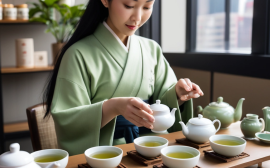The Global Tea Subscription Market: A Steep Growth Trajectory
From ancient rituals to modern wellness routines, tea has held a captivating allure for centuries. Today, this timeless beverage is experiencing a resurgence, not in traditional tea houses, but in the digital realm. The global tea subscription market is brewing a storm, fueled by evolving consumer preferences and the convenience of e-commerce. This transformation represents a significant shift in the global tea market, moving beyond conventional retail models to embrace the personalized and curated experiences that tea subscription boxes offer.
The intersection of food & drink trends with the burgeoning e-commerce sector has created a fertile ground for innovation and growth within the tea industry. The global tea subscription market’s steep growth trajectory is a testament to changing consumer behaviors and the power of online tea sales. Consumers, particularly millennials and Gen Z, are increasingly seeking curated experiences and personalized recommendations. Tea subscription services cater to this demand by offering a diverse selection of teas, often sourced directly from tea estates around the world, delivered directly to their doorsteps.
This direct-to-consumer (DTC) model cuts out traditional retail intermediaries, allowing tea companies to build stronger relationships with their customers and offer more competitive pricing. The appeal extends beyond mere convenience; it’s about discovering new flavors and understanding the nuances of different tea varieties. Wellness tea is a significant driver behind the surge in tea subscriptions. Consumers are proactively seeking natural and holistic health solutions, and tea, with its array of purported health benefits, fits seamlessly into this trend.
From calming chamomile to antioxidant-rich green tea and metabolism-boosting oolong, the perceived health benefits of various tea types are heavily marketed within the tea subscription box industry. Tea e-commerce platforms often highlight the specific health properties of each tea, catering to the growing segment of health-conscious consumers. This focus on wellness aligns with broader trends in the food and beverage industry, where consumers are increasingly prioritizing functional ingredients and health-promoting products. The rise of tea e-commerce is intrinsically linked to advancements in digital marketing and supply chain logistics.
Online platforms provide tea companies with unprecedented access to a global audience, allowing them to target specific consumer segments with tailored marketing campaigns. Social media platforms, in particular, have become powerful tools for building brand awareness and driving online tea sales. Furthermore, improvements in shipping and fulfillment infrastructure have made it easier and more cost-effective for tea companies to deliver their products directly to consumers, regardless of location. This efficient distribution network is crucial for the success of tea subscription services, which rely on timely and reliable delivery to maintain customer satisfaction.
However, the global tea subscription market faces challenges amidst its rapid expansion. Intense competition requires companies to differentiate themselves through unique offerings, such as rare tea varieties, sustainable sourcing practices, or personalized tea blends. Customer retention is another key concern, as consumers may be tempted to switch between different subscription services in search of better value or more exciting selections. Moreover, ensuring transparency and traceability throughout the supply chain is becoming increasingly important, as consumers are demanding more information about the origin and ethical production of their tea. Addressing these challenges will be crucial for the long-term sustainability and success of the tea subscription industry.
Wellness, Convenience, and the Rise of Tea Subscriptions
The global wellness movement has ignited a renewed interest in tea, transforming it from a simple beverage into a sought-after elixir. Health-conscious consumers, increasingly attuned to the benefits of natural remedies and preventative wellness, are driving the demand for functional beverages. Tea, with its rich history and diverse range of antioxidant properties, fits perfectly within this evolving landscape. This demand for wellness teas, coupled with the desire for convenience and exploration of unique flavor profiles, is fueling the rapid growth of tea subscription services.
Consumers are no longer content with the limited selection of supermarket staples; they crave curated experiences and access to rare and exotic teas from around the world. The tea subscription box model caters perfectly to this desire, offering a convenient and personalized way to discover new varieties and deepen their tea appreciation. The rise of e-commerce has played a pivotal role in the expansion of the tea subscription market. Online platforms provide a global reach for tea companies, both large and small, allowing them to connect directly with consumers and cultivate brand loyalty.
This direct-to-consumer approach bypasses traditional retail channels, creating new opportunities for smaller, artisanal tea producers to compete in the global market. Furthermore, the digital landscape allows for targeted marketing campaigns and personalized recommendations, enhancing the customer experience and driving sales. Data analytics provide valuable insights into consumer preferences, enabling tea subscription companies to refine their offerings and cater to specific tastes and wellness goals. For instance, a company might offer a “Stress Relief” subscription box featuring chamomile and lavender teas, or an “Immunity Boost” box with ginger and turmeric blends.
This level of personalization is a key driver of customer retention in the competitive tea subscription market. The global tea market is experiencing a significant shift, moving beyond traditional tea bags and loose leaf towards more specialized and curated offerings. The tea subscription industry, with its emphasis on premium quality, unique blends, and personalized experiences, is at the forefront of this transformation. According to market research, the global tea subscription market is projected to reach [insert hypothetical market value] by [insert hypothetical year], demonstrating the immense growth potential of this sector.
This growth is driven by several factors, including increasing disposable incomes in emerging markets, the growing popularity of online shopping, and a heightened awareness of the health benefits associated with tea consumption. Investors are taking note of this burgeoning market, with venture capital flowing into innovative tea subscription startups that are disrupting the traditional tea industry. Competition in the tea subscription landscape is intensifying, with companies vying for market share through innovative curation strategies and unique value propositions.
Some companies focus on single-origin teas, partnering directly with farmers in remote regions to offer exclusive and ethically sourced varieties. Others specialize in herbal infusions and wellness blends, capitalizing on the growing demand for functional beverages. Sustainable sourcing and ethical production practices are becoming increasingly important to consumers, and tea subscription companies are responding by prioritizing transparency and environmental responsibility. This commitment to sustainability not only resonates with environmentally conscious consumers but also contributes to the long-term viability of the tea industry.
The convenience factor of tea subscriptions is undeniable. Busy professionals and individuals with demanding lifestyles appreciate the ease and efficiency of having curated tea selections delivered directly to their doorstep. This subscription model eliminates the need for time-consuming trips to specialty tea shops or browsing through endless online options. Instead, subscribers receive a carefully curated selection of teas, often accompanied by detailed tasting notes and brewing instructions, allowing them to explore the world of tea with minimal effort. This convenience, combined with the element of surprise and discovery, has made tea subscriptions a popular choice for both seasoned tea connoisseurs and those new to the world of tea.
The Digital Brew: E-commerce and Tea Subscriptions
The digital revolution has fundamentally reshaped the tea industry, with e-commerce and digital marketing propelling the growth of tea subscriptions to new heights. Online platforms offer tea companies an unprecedented global reach, bypassing traditional retail barriers and connecting them directly with consumers worldwide. This direct-to-consumer model fosters deeper brand loyalty through personalized engagement and curated experiences. For instance, companies like Vahdam Teas in India leverage social media and email marketing to share stories about their sourcing practices and tea-making traditions, cultivating a loyal customer base that values transparency and authenticity.
This resonates particularly well with the millennial and Gen Z demographics, who prioritize ethical consumption and brand storytelling. The rise of mobile commerce and sophisticated e-commerce platforms has further amplified the accessibility of tea subscriptions. User-friendly interfaces, secure payment gateways, and streamlined subscription management tools enhance the customer experience, making it easier than ever to sign up for and manage recurring tea deliveries. Personalized recommendations, driven by data analytics and user preferences, introduce consumers to new varieties and flavor profiles, expanding their tea horizons and driving sales.
Data from Statista reveals a steady rise in online tea sales globally, with the market projected to reach billions of dollars by 2025, underscoring the robust growth of this sector. This growth is further fueled by targeted advertising campaigns that effectively reach specific consumer segments, such as wellness enthusiasts or those seeking unique and exotic tea blends. Subscription models are particularly well-suited to the digital landscape, providing tea companies with predictable recurring revenue streams and fostering long-term customer relationships.
The subscription box model, popularized by companies like Birchbox in the beauty industry, has found fertile ground in the tea sector. These curated boxes offer a delightful element of surprise and discovery, often featuring a selection of teas based on a specific theme, region, or flavor profile. This approach not only encourages repeat purchases but also cultivates a sense of community among subscribers, who often share their tasting experiences and discoveries online. Furthermore, the subscription model provides valuable data insights into consumer preferences, enabling companies to refine their offerings and personalize the customer experience even further.
The integration of social media marketing and influencer collaborations has also played a significant role in the rise of tea subscriptions. Tea brands partner with lifestyle and wellness influencers to showcase their products and reach wider audiences. This strategy leverages the trust and engagement built by influencers within their communities, driving brand awareness and generating organic interest in tea subscriptions. Moreover, social media platforms provide a valuable channel for customer feedback and interaction, allowing companies to gather real-time insights and adapt their offerings to meet evolving consumer demands.
The global tea market is experiencing a paradigm shift, transitioning from traditional brick-and-mortar retail to a digitally driven ecosystem, with tea subscriptions at the forefront of this transformation. This digital evolution also presents opportunities for smaller, artisanal tea producers to compete on a global scale. By leveraging e-commerce platforms and digital marketing strategies, these businesses can bypass traditional distribution channels and connect directly with consumers who appreciate unique, high-quality teas. This democratization of the tea industry empowers smaller players to carve out their niche in the market, contributing to the diversity and richness of the global tea landscape.
Competition and Innovation in the Tea Subscription Landscape
The tea subscription market is experiencing a surge in competition, transforming the landscape for both established players and emerging startups. Established brands leverage their existing infrastructure and brand recognition to maintain market share, focusing on expanding their online presence and optimizing their subscription models. Meanwhile, innovative startups are disrupting traditional business models by offering niche tea selections, personalized experiences, and flexible subscription options. This dynamic interplay between established giants and agile newcomers fuels innovation and pushes the industry towards higher quality, greater customer value, and ultimately, a more diverse and accessible tea market.
For example, large tea brands like Twinings and Bigelow are expanding their e-commerce platforms to offer curated tea subscription boxes, directly competing with smaller, specialized online tea retailers. This competition benefits consumers through wider product variety, competitive pricing, and enhanced subscription services. One key area of differentiation in this competitive market is curation. Companies are moving beyond basic tea selections to offer curated experiences based on specific flavor profiles, health benefits, or regional origins. For instance, some tea subscription services focus on single-origin teas, providing customers with a journey through the diverse terroirs of the tea-producing world.
Others curate boxes around wellness themes, offering blends designed for relaxation, energy boost, or immune support. This targeted approach allows companies to cater to specific consumer needs and preferences, driving customer loyalty and market segmentation within the broader tea industry. The global tea market is experiencing a shift in consumer behavior, with a growing demand for personalized experiences and unique product offerings. This trend is reflected in the tea subscription box market, where companies are leveraging data and technology to tailor their offerings to individual customer preferences.
Personalized recommendations, customizable subscription options, and interactive online communities are becoming increasingly common, enhancing customer engagement and fostering brand loyalty. This shift towards personalization is further fueled by the growing wellness tea trend, with consumers seeking specific tea blends to address individual health and wellness goals. This convergence of personalized wellness and convenient tea delivery is a significant driver of growth in the online tea sales sector. Sustainability is another crucial factor shaping the competitive landscape.
Consumers are increasingly conscious of the environmental and social impact of their purchasing decisions, and tea companies are responding by prioritizing sustainable sourcing practices. Certifications like Fair Trade and Rainforest Alliance are becoming increasingly important, demonstrating a commitment to ethical sourcing and environmental responsibility. Furthermore, companies are adopting eco-friendly packaging and minimizing their carbon footprint throughout the supply chain. This focus on sustainability not only resonates with environmentally conscious consumers but also contributes to the long-term health of the tea industry and the global economy.
The rise of tea e-commerce and subscription services presents both opportunities and challenges for businesses operating in this space. While the expanding global tea market offers significant growth potential, companies must navigate complex supply chain logistics, fluctuating commodity prices, and evolving consumer preferences. Maintaining customer retention in a competitive market requires continuous innovation, personalized service, and a strong focus on quality and value. Furthermore, understanding and adapting to regional preferences and cultural nuances is crucial for companies seeking to expand their reach in the international tea market. Successfully navigating these complexities will be key to unlocking the full potential of the burgeoning tea subscription industry and securing a sustainable position in the global economy.
The Future of Tea Subscriptions: Challenges and Opportunities
The global tea subscription market is poised for a dynamic future, with robust growth projections fueled by evolving consumer preferences and technological advancements. This burgeoning sector, operating at the intersection of e-commerce, the food and beverage industry, and the global economy, presents both exciting opportunities and significant challenges for businesses. While the convenience and curated experiences offered by tea subscription boxes have captivated a growing consumer base, companies must navigate complex supply chains, sustainability concerns, and increasing competition to maintain momentum.
The rise of wellness teas, driven by health-conscious consumers, further fuels this market, creating a niche within the broader tea industry trends. This demand for premium, often organic and ethically sourced, teas presents opportunities for businesses to differentiate themselves through transparent sourcing and high-quality offerings. One key challenge lies in optimizing the supply chain for a product inherently sensitive to environmental factors. Transporting delicate tea leaves from origin countries across the globe requires meticulous logistical planning and temperature-controlled environments to preserve quality and freshness.
Companies like Vahdam Teas, a prominent player in the online tea sales space, are investing in innovative packaging and logistics solutions to address these challenges. Their direct-to-consumer model, bypassing traditional intermediaries, allows for greater control over the supply chain and faster delivery times, enhancing the customer experience and reducing environmental impact. This focus on efficient tea delivery is crucial for maintaining customer satisfaction and building brand loyalty in the competitive tea subscription landscape. Furthermore, sustainability is no longer a niche concern but a core consumer value.
The tea industry, with its historical ties to colonial practices, faces increasing scrutiny regarding ethical sourcing and environmental impact. Tea subscription services that prioritize fair trade practices, support small-scale farmers, and minimize packaging waste are gaining a competitive edge. For example, The Tea Spot, a subscription service specializing in whole-leaf teas, emphasizes its commitment to sustainable agriculture and community development projects in its sourcing regions. By aligning with consumer values, these companies not only contribute to a more ethical and sustainable tea industry but also strengthen their brand image and attract environmentally conscious customers.
The digital realm plays a crucial role in the growth of tea e-commerce and subscription services. Targeted advertising and personalized recommendations, powered by sophisticated algorithms, allow companies to connect with specific consumer segments and offer curated tea selections tailored to individual preferences. This personalized approach enhances customer engagement and drives sales. Moreover, online platforms facilitate the creation of interactive tea communities, where subscribers can share their experiences, learn about different tea varieties, and connect with the brand.
This fosters a sense of belonging and brand loyalty, further solidifying the position of tea subscriptions in the online marketplace. Emerging markets, particularly in Asia and Africa, present significant growth opportunities for the global tea market. These regions boast rich tea-drinking traditions and a growing middle class with increasing disposable income. However, navigating cultural nuances and logistical complexities in these markets requires careful consideration. Companies must adapt their offerings to local tastes and preferences, considering factors such as preferred tea types, brewing methods, and cultural significance. Understanding regional tea industry trends and consumer behavior is essential for successful market entry and expansion. As the global tea subscription market continues to evolve, companies that prioritize sustainability, innovation, and customer-centricity are best positioned to capitalize on the expanding opportunities and navigate the challenges ahead.



